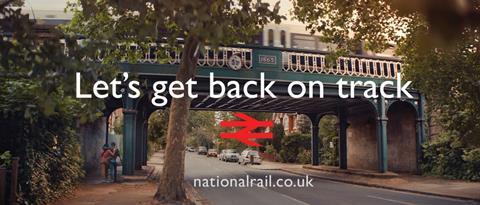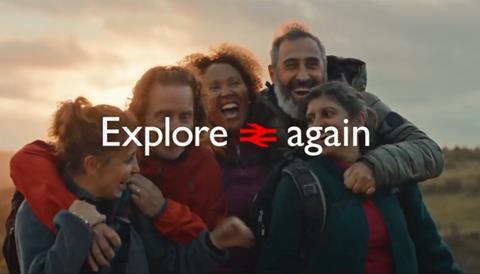
UK: The first co-ordinated national marketing campaign since the start of the coronavirus pandemic was launched by the rail industry on August 16.
Branded ‘Let’s get back on track’, the campaign is primarily aimed at leisure travellers, including television, radio and video on-demand advertising, social media, billboards and posters on stations, bus shelters and shopping centres.

The campaign is intended to encourage people to travel by train for days out and weekends away ‘by featuring moments of joy made possible by rail, such as grandparents meeting their new grandchild for the first time and a couple being reunited after months apart during lockdown’.
Rail Business UK understands that plans for the campaign had been in place for some time, but a proposed launch in early summer was delayed following a significant rise in Covid-19 infections. According to industry insiders, ‘cautious’ civil servants at the Department for Transport had ‘overridden the enthusiasm from ministers to spend on promotional activities’.

Ridership figures suggest that leisure travel is recovering quickly, with revenue now at 56% of pre-pandemic levels. The Rail Delivery Group reports strong growth following the lifting of government restrictions, with leisure traffic up 10% since ‘Freedom Day’ on July 19. However, concerns remain around a car-led recovery. According to a recent survey by VisitBritain, two-thirds of people taking holiday breaks in the UK this summer say they will do so by car, compared to just 16% who will take the train.
Among travellers returning to rail, young people are reported to be the keenest. Total railcard sales are up 6·5% compared to 2019, thanks to strong sales of 26-30 and 16-25 railcards ahead of industry expectations.
However, the ‘back on track’ campaign is also designed to boost local businesses. According to research conducted for RDG by WPI Economics, rail passengers travelling for leisure spend on average £107 per trip on shopping, restaurants and hotels, generating £46bn for those businesses. The biggest spending is on food and drink at £15bn per year (an average of £33 per trip), followed by £12bn for shopping (£31 per trip), £10bn on accommodation (£21 per trip), and £5bn on entertainment and culture (£12 per trip).

‘As life starts to get back on track this summer, we’re looking forward to connecting more customers with the people and places they love, whether that’s a seaside trip with family, a night out with friends or a solo shopping spree’, said RDG Chief Executive Jacqueline Starr. ‘Taking a train is more than a journey; it’s a step towards a fair recovery today — boosting businesses that have struggled throughout the pandemic — as well as a clean economy tomorrow.’
Fare increase concerns
Whilst the first marketing campaign will focus on leisure travel, further promotional efforts in the autumn are expected to be targeted firmly at the commuter market. Reports that used car sales are increasing rapidly are fuelling concern among rail professionals that once people have invested in a car they will want to extract value from it. Having ‘sunk’ their money, they will be reluctant to leave the car at home and pay again for an expensive season ticket.

The return to commuting may be further impacted by any fares rises announced by the government. Annual fare increases in recent years have been based on the Retail Prices Index figure for July, which is expected to be relatively high. Some insiders anticipate that DfT may follow its example of 2020 and defer any fare increase from January until next spring. Although more details may emerge following the next Comprehensive Spending Review, the current expectation is that an increase of RPI+1% in March 2022 is most likely.
Given its concerns over a switch to car use RDG is expected to repeat its more robust messaging of recent years, reminding travellers that fare increases are determined by government. It is also expected to take a strong environmental stance, highlighting the fact that rail is a greener form of transport, yet governments have repeatedly increased rail fares whilst the freeze in fuel duty since 2010 means the UK’s CO2 emissions are up to 5% higher than they would otherwise have been. With the COP 26 climate summit on the horizon, this may prove difficult for ministers to defend.

RDG will continue to push for improvements to the ‘flawed’ flexible season ticket offer and remind government that the time is right for a wholescale review of the fares system. This remains a challenge, as any changes run the risk of not being revenue neutral. One RDG insider told Rail Business UK ‘that puts it back with the Treasury, which is determined not to be losing any money’.
Meanwhile train operators must also look at matching capacity with demand if part-time commuting between Tuesday and Thursday becomes a new normal. This does not just relate to the days of the week, but across the day as well. In recent weeks some railway staff have been taking to social media to pose questions like ‘why are we running eight-car sets almost entirely empty in the peaks and then reducing them to four cars, only to be wedged with leisure passengers through the off-peak hours?’



